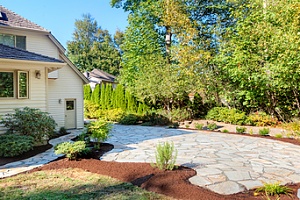 A stone path is an elegant and functional addition to a home’s yard or an office building entryway. The path can protect the surrounding landscaping by providing visitors with a clear lane in which to walk while also adding some decoration to your space. You can easily build a stone path over the course of a weekend thanks to its simple construction method and small list of materials. While many homeowners choose to simple place some stepping stones in their lawn leading to the front door, a little bit of extra effort can result in a truly show stopping centerpiece that gives your home or office some character at an affordable price. Here’s how to make a stone path that will instantly brighten up your yard or other outdoor space.
A stone path is an elegant and functional addition to a home’s yard or an office building entryway. The path can protect the surrounding landscaping by providing visitors with a clear lane in which to walk while also adding some decoration to your space. You can easily build a stone path over the course of a weekend thanks to its simple construction method and small list of materials. While many homeowners choose to simple place some stepping stones in their lawn leading to the front door, a little bit of extra effort can result in a truly show stopping centerpiece that gives your home or office some character at an affordable price. Here’s how to make a stone path that will instantly brighten up your yard or other outdoor space.
Materials
Stone paths can be made out of a number of materials. You can make the path stand out by choosing stones in colors and textures that differ from your home or office building, or tie it all together with a complementary color scheme. Whatever material or color of stone you choose, be sure to select stone with a texture that will not become slippery when it gets wet. Take the color into consideration as well. Darker stones tend to reach scorching temperatures, making them uncomfortable for people walking with bare feet in the summer.
In addition to stone steps, you will need fill dirt, a yardstick or measuring tape, a level, weed barrier material such as landscapers cloth, pebbles or grass, garden shears, and edging, if desired. The number of stones required will depend on their size and the length of the walkway, so measure both the area and the materials in advance to ensure that you have purchased enough.
How to Make a Stone Path
First, determine the boundaries of your stone path and remove all plants, weeds, and other materials from the area. Then, grade the land with fill dirt. Placing your stones on a completely flat and level area makes it easier and safer to walk on the path, as it will ensure that the stones lay flush with the ground and help prevent falls. Ensure that the entire area to be used for your path is level by filling in and smoothing out areas in which the elevation might change. Fill dirt is ideally suited to this task because it contains little to no organic matter and can be easily compacted to form a tight seal. Use a flat piece of wood to smooth the dirt and compact it into place.
 Once you have leveled the land, sprinkle topsoil over the area. This will help the stones lock into place and prevent them from slipping around, which could also cause accidents. Be careful not to use too much soil, as doing so may make the land bumpy again. You should only use enough topsoil to ensure that the stepping stones will not be moved significantly once they are placed in the ground.
Once you have leveled the land, sprinkle topsoil over the area. This will help the stones lock into place and prevent them from slipping around, which could also cause accidents. Be careful not to use too much soil, as doing so may make the land bumpy again. You should only use enough topsoil to ensure that the stepping stones will not be moved significantly once they are placed in the ground.
Next, lay the stones of your path. Set them about six to eight inches apart and keep them level. Press them into the topsoil to lock them in place, being sure to keep the majority of the stone well above the surface of the soil. Use a level to check the surface of each stone before placing the next one and make adjustments as necessary. When the level is parallel to the building, the bubble should appear in the middle of the level. When it is perpendicular, look for a slight positive slope, which indicates that water will be able to easily slide off the stones and prevent flooding or pooling water.
After ensuring that the stones are in the proper place, install a weed barrier. This will help prevent weeds from growing in between the stones and make it easier to maintain the area. Lay the cloth on top of the stones and use garden shears to cut a hole for each stone. Be sure to cut close to the stones for a snug fit. Looser outlines will allow more weeds to come through in between the stones. It may be helpful to weigh the weed barrier down with bricks or other heavy materials as you work.
After the weed barrier has been installed, you can fill the area around the stones with your preferred covering. Depending on your style and the architecture of the building, you may choose to fill it in with a variety of materials. Sod can be used to create a natural and simple look, while wood chips look more rustic and evoke log cabins and the mountains. Pebbles, meanwhile, are often appropriate for desert and seaside inspired decor alike. Whatever fill you choose, it should remain slightly lower than the top of the stones.
Depending on the type of fill material, you may want to install edging to prevent it from sliding into the lawn and other landscape elements. A narrow strip of black metal provides almost no interruption between the lawn and the path, though stone pavers that match your stone steps in the path can also be used. Dig a trench deep enough to leave about an inch of edging above the fill material and press the edging into the trench to complete the path.
Acquiring Your Fill Dirt
 Speak with Dirt Connections for more information about home construction projects and the use of fill dirt to give each one a smooth foundation. The firm’s experienced contractors can assist you in determining the amount of fill dirt needed for your project and give you information about how to best level your land before installing a stone path. Dirt Connections provides free consultations and fill dirt delivery, and the firm can even remove excess fill dirt after your project is complete to leave your yard in perfect condition. In addition to its fill dirt services, Dirt Connections can also provide pool removals, residential and commercial construction, and more.
Speak with Dirt Connections for more information about home construction projects and the use of fill dirt to give each one a smooth foundation. The firm’s experienced contractors can assist you in determining the amount of fill dirt needed for your project and give you information about how to best level your land before installing a stone path. Dirt Connections provides free consultations and fill dirt delivery, and the firm can even remove excess fill dirt after your project is complete to leave your yard in perfect condition. In addition to its fill dirt services, Dirt Connections can also provide pool removals, residential and commercial construction, and more.








































